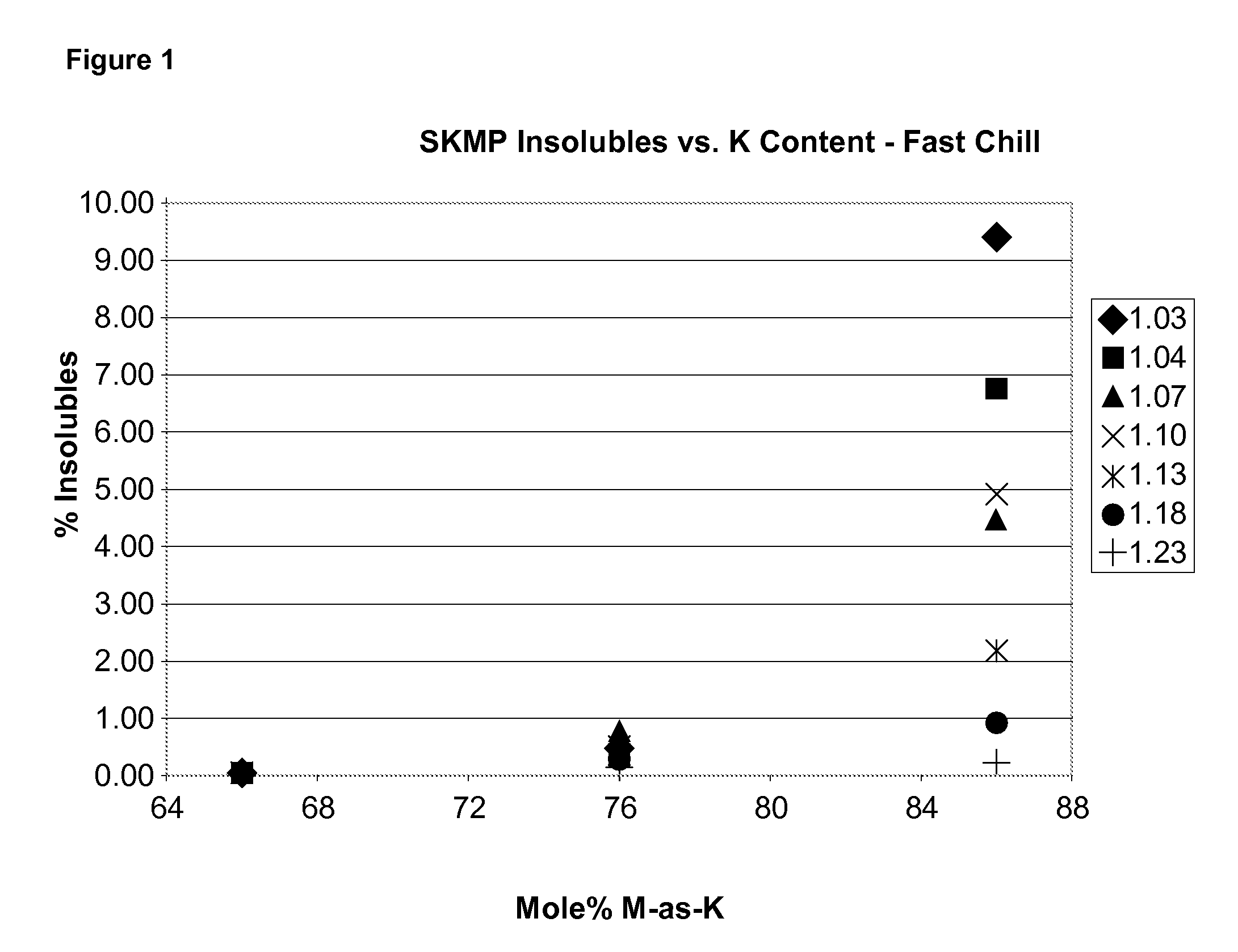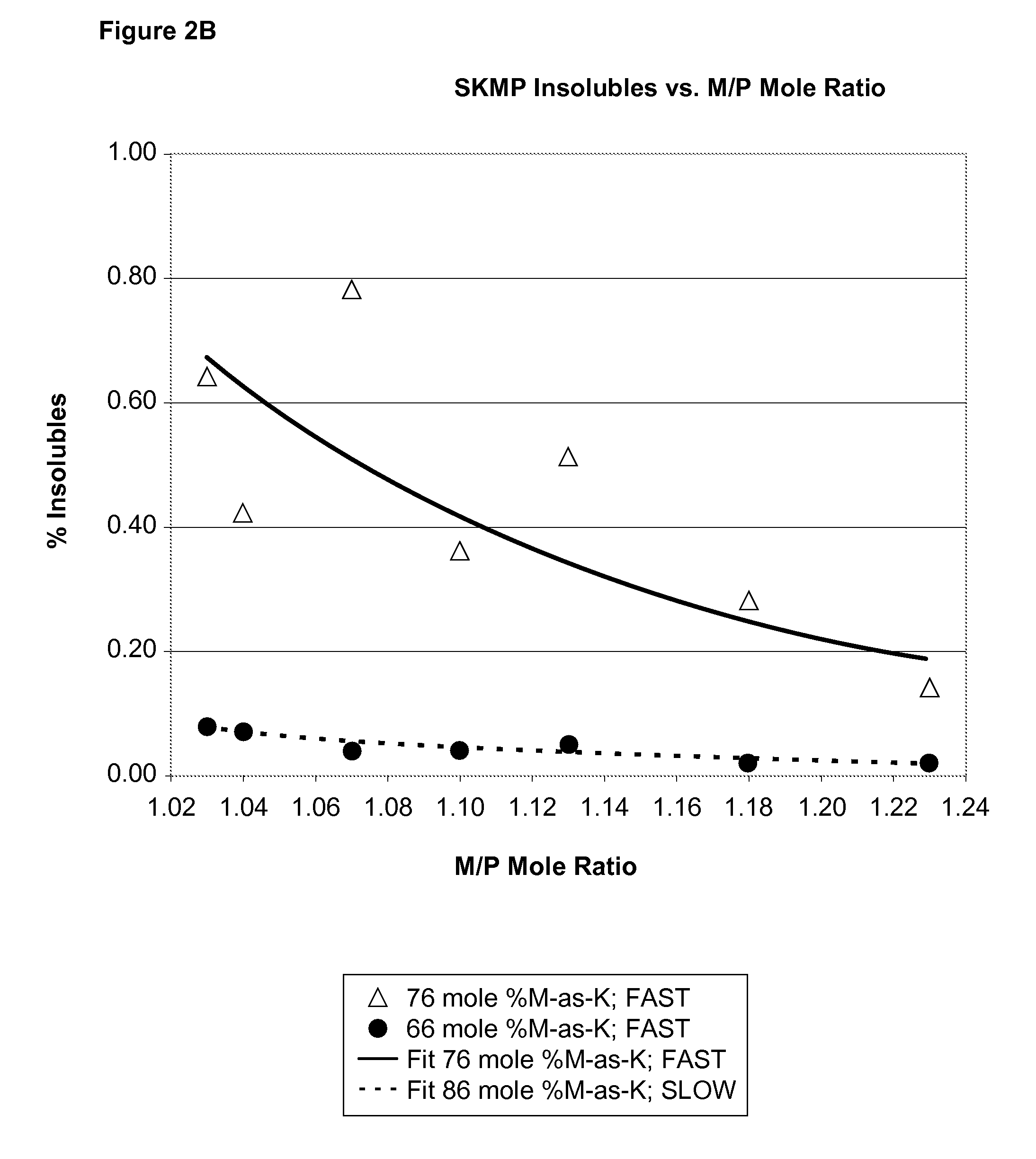Sodium-Potassium Hexametaphosphate and Potassium Metaphosphate with a Low Insolubles Content
a technology of potassium metaphosphate and potassium hexametaphosphate, which is applied in the field of potassium-containing polyphosphate glass compositions, can solve the problems of low insoluble content, slow dissolution, and compositions that have not been widely used in food applications, and achieve the effect of reducing the amount of water insoluble materials
- Summary
- Abstract
- Description
- Claims
- Application Information
AI Technical Summary
Benefits of technology
Problems solved by technology
Method used
Image
Examples
example 1
[0089]The following example illustrates the preparation of SKMP with a relatively high potassium to sodium ratio without the addition of glass-former additives, and the amount of insolubles present in the resulting glass when either a rapid or slow rate of cooling is used to solidify the melt.
[0090]The sodium and potassium phosphates in the quantities and proportions indicated in Table 1 were mixed together in an uncovered inert metal dish and heated to 900° C. for 10-20 minutes in a muffle furnace. The total final weight of the melt in each instance was 50.0 g. In this example, the melts were subjected to a “fast chill” that was achieved by pouring about one-half of resulting melt between two large copper chill plates and then the second half was quenched the same way. Each chill plate is at ambient temperature, weighs approximately 19 kg and has dimensions of ⅞ inch×12×inches×12 inches. A person skilled in the art will readily appreciate that differences in the weight of the melt,...
example 2
[0096]Preparations were made of samples with 1.07 M / P mole ratio, 76 mole % M-as-K, and slow cooling, and were used to assess the impact of additives on insolubles formation. The additives chosen included sodium tetraborate and Kasil 6. The latter contains silica and was tested to determine whether silica-containing materials would be appropriate glass-forming additives. The amounts of the additives are listed in Table 8. As provided in Table 1, the ingredients for 1.07 M / P mole ratio, 76 mole % M-as-K SKMP are 39.07 g of monopotassium phosphate anhydrous (MKPA), 5.20 g dipotassium phosphate anhydrous (DKPA), and 15.11 g of monosodium phosphate monohydrate, which is equivalent to 13.14 g of monosodium phosphate anhydrous (MSPA). The ingredients, including any additives, were mixed and heated to 900° C. for 10-20 min. The entire melt was poured onto a single copper chill plate and allowed to cool, i.e., slow chill. The total final weight of melt (anhydrous weight, before additives) w...
example 3
[0098]To evaluate the impact of various boron-containing glass-formers on insolubles formation in SKMP, preparations were made of the samples with 1.07 M / P mole ratio, 76% M-as-K, and slow cooling, and were used to assess the impact of additives on insolubles formation. The additives chosen included K2B4O7, B2O3, Na2B4O7, H3B2O3, KB5O8, and NaBO2 were added in amounts that correspond to the amounts of B2O3 added to the melt / glass listed in Table 10. The ingredients, including any additives, were mixed and heated to about 900° C. and maintained at about that temperature for a duration n between about 10 and about 20 minutes. The analysis results are in Table 10.
TABLE 1076 mole % M-as-K SLOW CHILLwt %B2O3Ave.Targetfromwt %Chainwt %Measuredwt %SampleM / PAdditiveadditiveinsolublesLengthP2O5M / PpHH2O0176-1.07none—8.0617.3160.41.0687.130.37091-70359-1.07K2B4O7•4H2O0.600.296016-010359-1.07B2O31.000.1438.1459.781.0676.41.35016-020359-1.07Na2B4O7•10H2O0.690.1348.7459.641.086.721.13016-030359-1...
PUM
| Property | Measurement | Unit |
|---|---|---|
| Fraction | aaaaa | aaaaa |
| Fraction | aaaaa | aaaaa |
| Fraction | aaaaa | aaaaa |
Abstract
Description
Claims
Application Information
 Login to View More
Login to View More - R&D
- Intellectual Property
- Life Sciences
- Materials
- Tech Scout
- Unparalleled Data Quality
- Higher Quality Content
- 60% Fewer Hallucinations
Browse by: Latest US Patents, China's latest patents, Technical Efficacy Thesaurus, Application Domain, Technology Topic, Popular Technical Reports.
© 2025 PatSnap. All rights reserved.Legal|Privacy policy|Modern Slavery Act Transparency Statement|Sitemap|About US| Contact US: help@patsnap.com



